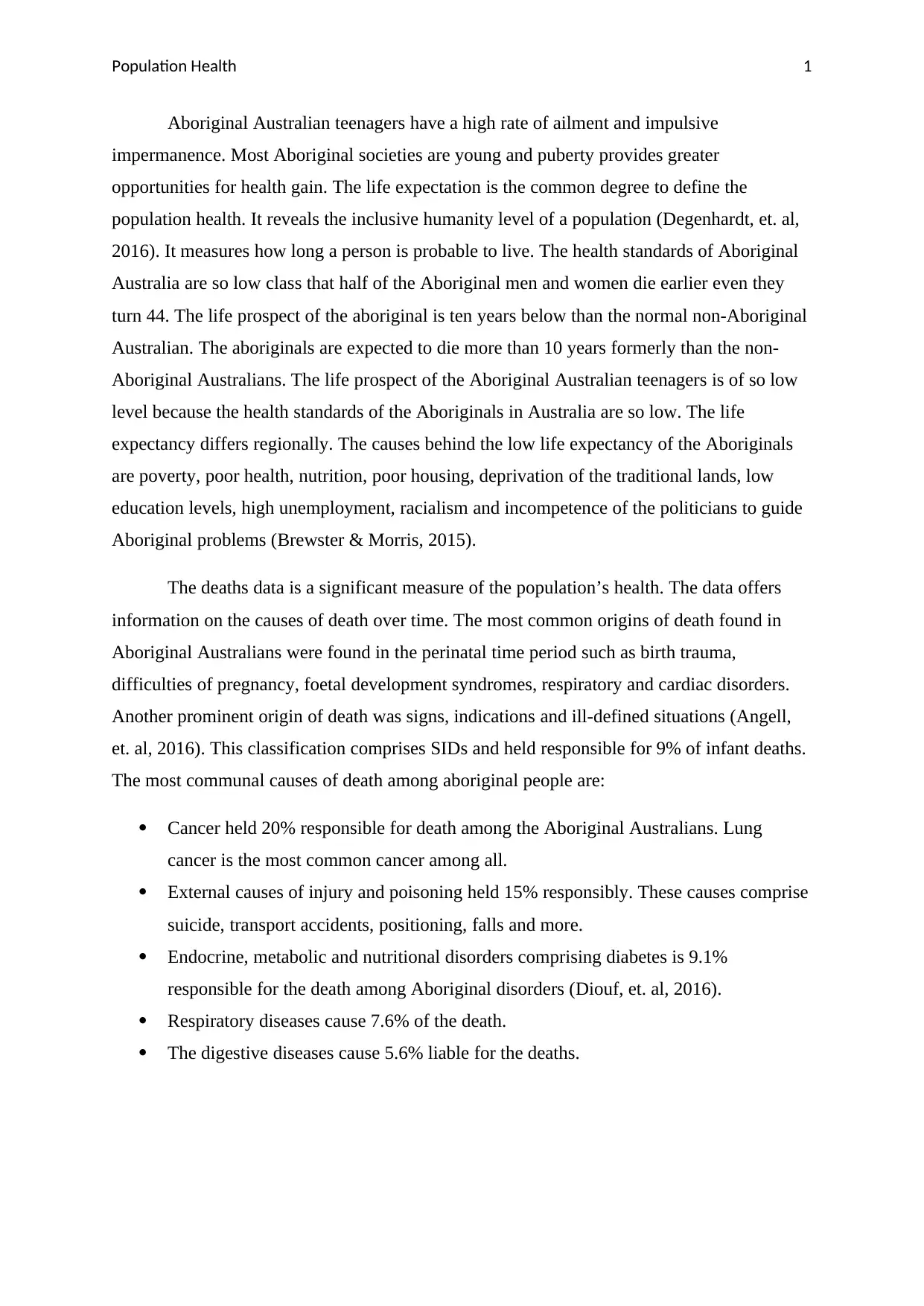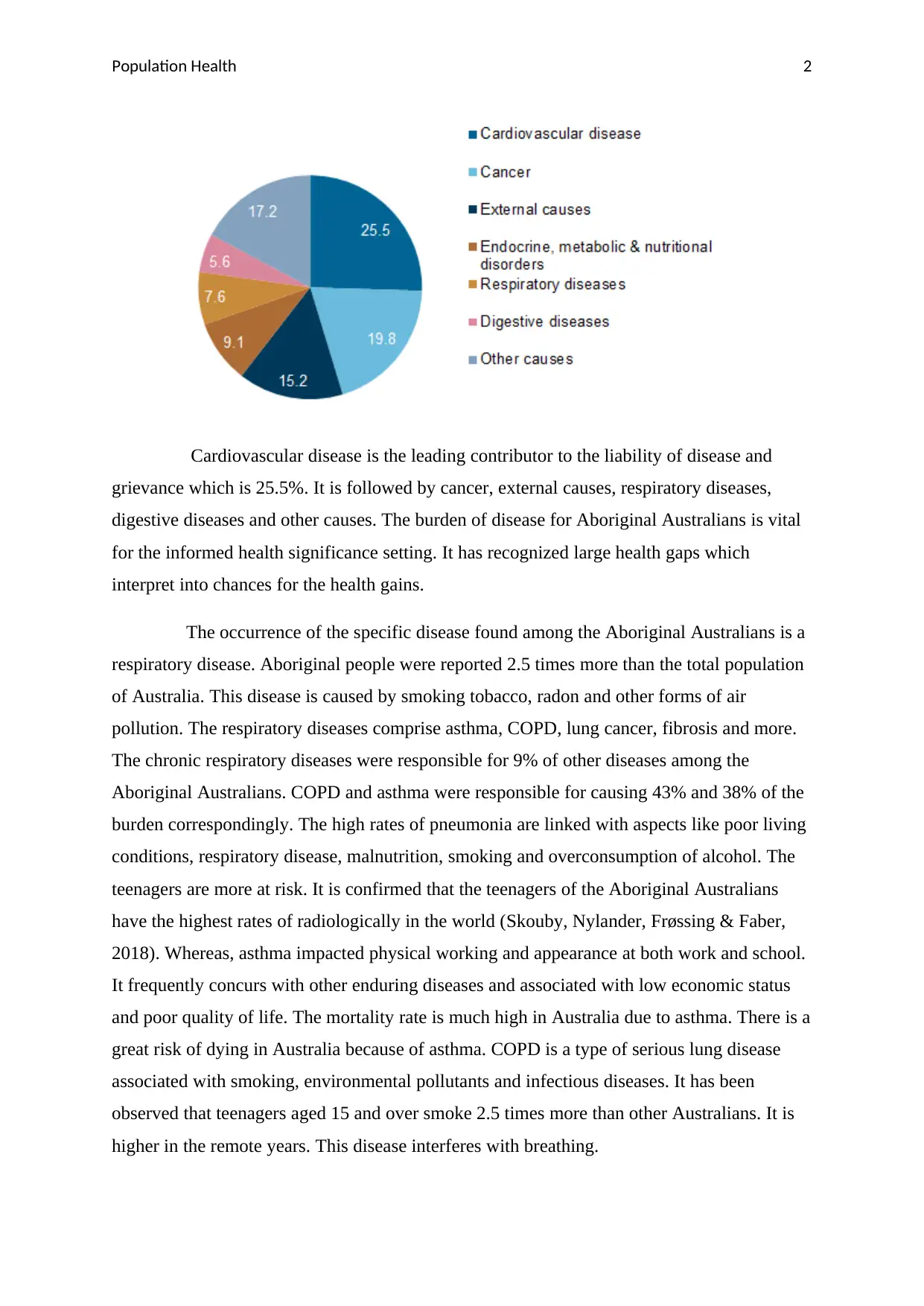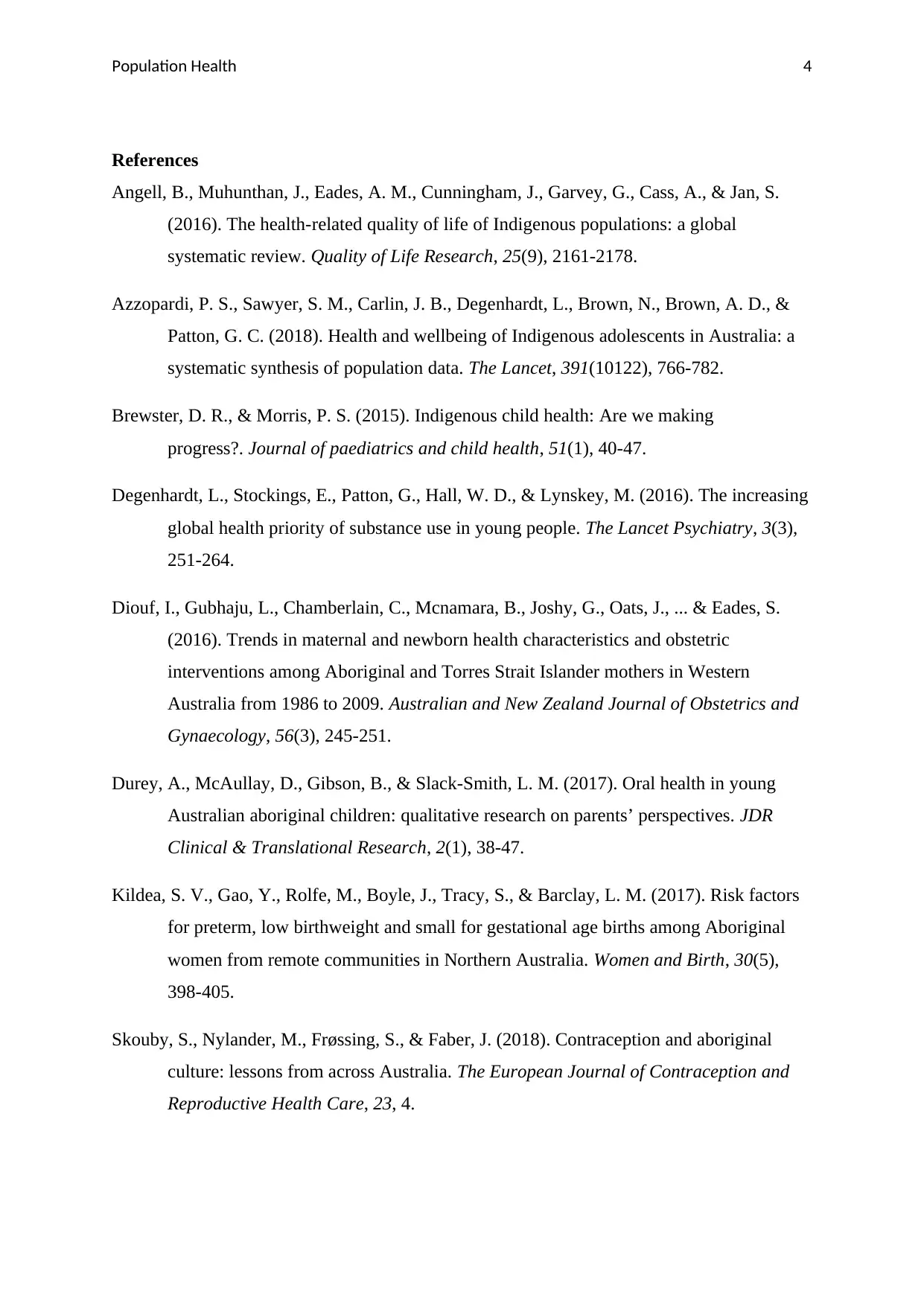Comprehensive Report: Population Health of Aboriginal Australians
VerifiedAdded on 2023/06/03
|5
|1595
|471
Report
AI Summary
This report provides an in-depth analysis of the population health of Aboriginal Australians, focusing on the significant health disparities and challenges they face. It highlights the low life expectancy, which is attributed to various factors including poverty, poor health, inadequate nutrition, substandard housing, and systemic issues like racialism and lack of political action. The report delves into the leading causes of death, such as perinatal conditions, cancers (particularly lung cancer), external injuries, and metabolic disorders like diabetes. Respiratory diseases, including asthma and COPD, are also identified as major contributors to morbidity. Preventable risk factors, especially tobacco consumption, are emphasized as primary drivers of disease burden, leading to cardiovascular diseases, chronic pulmonary diseases, and various cancers. The report underscores the impact of smoking on mortality rates and the potential for increased life expectancy through cessation. It also examines regional variations in smoking patterns and their association with smoking-related diseases. The research references multiple studies and data to support its findings and recommendations for improving Aboriginal health outcomes.

RUNNING HEAD: Population Health 0
Population Health
Population Health
Paraphrase This Document
Need a fresh take? Get an instant paraphrase of this document with our AI Paraphraser

Population Health 1
Aboriginal Australian teenagers have a high rate of ailment and impulsive
impermanence. Most Aboriginal societies are young and puberty provides greater
opportunities for health gain. The life expectation is the common degree to define the
population health. It reveals the inclusive humanity level of a population (Degenhardt, et. al,
2016). It measures how long a person is probable to live. The health standards of Aboriginal
Australia are so low class that half of the Aboriginal men and women die earlier even they
turn 44. The life prospect of the aboriginal is ten years below than the normal non-Aboriginal
Australian. The aboriginals are expected to die more than 10 years formerly than the non-
Aboriginal Australians. The life prospect of the Aboriginal Australian teenagers is of so low
level because the health standards of the Aboriginals in Australia are so low. The life
expectancy differs regionally. The causes behind the low life expectancy of the Aboriginals
are poverty, poor health, nutrition, poor housing, deprivation of the traditional lands, low
education levels, high unemployment, racialism and incompetence of the politicians to guide
Aboriginal problems (Brewster & Morris, 2015).
The deaths data is a significant measure of the population’s health. The data offers
information on the causes of death over time. The most common origins of death found in
Aboriginal Australians were found in the perinatal time period such as birth trauma,
difficulties of pregnancy, foetal development syndromes, respiratory and cardiac disorders.
Another prominent origin of death was signs, indications and ill-defined situations (Angell,
et. al, 2016). This classification comprises SIDs and held responsible for 9% of infant deaths.
The most communal causes of death among aboriginal people are:
Cancer held 20% responsible for death among the Aboriginal Australians. Lung
cancer is the most common cancer among all.
External causes of injury and poisoning held 15% responsibly. These causes comprise
suicide, transport accidents, positioning, falls and more.
Endocrine, metabolic and nutritional disorders comprising diabetes is 9.1%
responsible for the death among Aboriginal disorders (Diouf, et. al, 2016).
Respiratory diseases cause 7.6% of the death.
The digestive diseases cause 5.6% liable for the deaths.
Aboriginal Australian teenagers have a high rate of ailment and impulsive
impermanence. Most Aboriginal societies are young and puberty provides greater
opportunities for health gain. The life expectation is the common degree to define the
population health. It reveals the inclusive humanity level of a population (Degenhardt, et. al,
2016). It measures how long a person is probable to live. The health standards of Aboriginal
Australia are so low class that half of the Aboriginal men and women die earlier even they
turn 44. The life prospect of the aboriginal is ten years below than the normal non-Aboriginal
Australian. The aboriginals are expected to die more than 10 years formerly than the non-
Aboriginal Australians. The life prospect of the Aboriginal Australian teenagers is of so low
level because the health standards of the Aboriginals in Australia are so low. The life
expectancy differs regionally. The causes behind the low life expectancy of the Aboriginals
are poverty, poor health, nutrition, poor housing, deprivation of the traditional lands, low
education levels, high unemployment, racialism and incompetence of the politicians to guide
Aboriginal problems (Brewster & Morris, 2015).
The deaths data is a significant measure of the population’s health. The data offers
information on the causes of death over time. The most common origins of death found in
Aboriginal Australians were found in the perinatal time period such as birth trauma,
difficulties of pregnancy, foetal development syndromes, respiratory and cardiac disorders.
Another prominent origin of death was signs, indications and ill-defined situations (Angell,
et. al, 2016). This classification comprises SIDs and held responsible for 9% of infant deaths.
The most communal causes of death among aboriginal people are:
Cancer held 20% responsible for death among the Aboriginal Australians. Lung
cancer is the most common cancer among all.
External causes of injury and poisoning held 15% responsibly. These causes comprise
suicide, transport accidents, positioning, falls and more.
Endocrine, metabolic and nutritional disorders comprising diabetes is 9.1%
responsible for the death among Aboriginal disorders (Diouf, et. al, 2016).
Respiratory diseases cause 7.6% of the death.
The digestive diseases cause 5.6% liable for the deaths.

Population Health 2
Cardiovascular disease is the leading contributor to the liability of disease and
grievance which is 25.5%. It is followed by cancer, external causes, respiratory diseases,
digestive diseases and other causes. The burden of disease for Aboriginal Australians is vital
for the informed health significance setting. It has recognized large health gaps which
interpret into chances for the health gains.
The occurrence of the specific disease found among the Aboriginal Australians is a
respiratory disease. Aboriginal people were reported 2.5 times more than the total population
of Australia. This disease is caused by smoking tobacco, radon and other forms of air
pollution. The respiratory diseases comprise asthma, COPD, lung cancer, fibrosis and more.
The chronic respiratory diseases were responsible for 9% of other diseases among the
Aboriginal Australians. COPD and asthma were responsible for causing 43% and 38% of the
burden correspondingly. The high rates of pneumonia are linked with aspects like poor living
conditions, respiratory disease, malnutrition, smoking and overconsumption of alcohol. The
teenagers are more at risk. It is confirmed that the teenagers of the Aboriginal Australians
have the highest rates of radiologically in the world (Skouby, Nylander, Frøssing & Faber,
2018). Whereas, asthma impacted physical working and appearance at both work and school.
It frequently concurs with other enduring diseases and associated with low economic status
and poor quality of life. The mortality rate is much high in Australia due to asthma. There is a
great risk of dying in Australia because of asthma. COPD is a type of serious lung disease
associated with smoking, environmental pollutants and infectious diseases. It has been
observed that teenagers aged 15 and over smoke 2.5 times more than other Australians. It is
higher in the remote years. This disease interferes with breathing.
Cardiovascular disease is the leading contributor to the liability of disease and
grievance which is 25.5%. It is followed by cancer, external causes, respiratory diseases,
digestive diseases and other causes. The burden of disease for Aboriginal Australians is vital
for the informed health significance setting. It has recognized large health gaps which
interpret into chances for the health gains.
The occurrence of the specific disease found among the Aboriginal Australians is a
respiratory disease. Aboriginal people were reported 2.5 times more than the total population
of Australia. This disease is caused by smoking tobacco, radon and other forms of air
pollution. The respiratory diseases comprise asthma, COPD, lung cancer, fibrosis and more.
The chronic respiratory diseases were responsible for 9% of other diseases among the
Aboriginal Australians. COPD and asthma were responsible for causing 43% and 38% of the
burden correspondingly. The high rates of pneumonia are linked with aspects like poor living
conditions, respiratory disease, malnutrition, smoking and overconsumption of alcohol. The
teenagers are more at risk. It is confirmed that the teenagers of the Aboriginal Australians
have the highest rates of radiologically in the world (Skouby, Nylander, Frøssing & Faber,
2018). Whereas, asthma impacted physical working and appearance at both work and school.
It frequently concurs with other enduring diseases and associated with low economic status
and poor quality of life. The mortality rate is much high in Australia due to asthma. There is a
great risk of dying in Australia because of asthma. COPD is a type of serious lung disease
associated with smoking, environmental pollutants and infectious diseases. It has been
observed that teenagers aged 15 and over smoke 2.5 times more than other Australians. It is
higher in the remote years. This disease interferes with breathing.
⊘ This is a preview!⊘
Do you want full access?
Subscribe today to unlock all pages.

Trusted by 1+ million students worldwide

Population Health 3
The preventable risk factors attribute to the leading factors for Aboriginal Australian
contributes to the causes of death and injury. The consumption of tobacco held accountable
for 12.3% of the burden of ailment which is more than any former risk elements and more
than liquor and prohibited medications. This quantity is higher than another burden of
diseases (Kildea, et. al, 2017). It resulted in coronary heart diseases were the leading disease
attributed to the use of smoking. It is monitored by chronic disruptive pulmonary disease,
stroke and lung cancer. Smoking instigated 93% of the lung cancer, 87% of the COPD drain,
71% of the oesophageal cancer burden and 64% of the mouth cancer. The smoking is
increasing with age and more in men than women (Azzopardi, et. al, 2018).
It can be concluded that smoking causes deaths amongst Aboriginal Australians can
be eradicated. The normal life expectancy can upsurge by two and half years for the males
and 1.7 years for the females. It is significant to enumerate deaths due to smoking among the
Aboriginal Australians. Smoking instigated twenty three percent of the deaths amongst the
Aboriginal males and 17% of deaths among the Aboriginal females. The regional differences
in the Aboriginal’s smoking patterns reflect that people are more likely to die from the
diseases instigated by smoking. The deaths because of smoking are caused by lung cancer,
ischaemic heart disease, stroke, pneumonia, COPD, oropharyngeal cancer. Ischaemic heart
disease is the leading cause of death. The Aboriginal women died 4 times the rate of non-
aboriginal women. The aboriginal men died two and a half times than the non-indigenous
men. The death rates for the smoking caused diseases have increased substantially among the
Aboriginal Australians. The upsurges in smoking-caused disease ensued from thirty five
years of age associated with forty five years of age (Durey, McAullay, Gibson & Slack-
Smith, 2017). According to the Western report, it was found that the smoking caused deaths
mainly in the teenagers due to over-consumption.
The preventable risk factors attribute to the leading factors for Aboriginal Australian
contributes to the causes of death and injury. The consumption of tobacco held accountable
for 12.3% of the burden of ailment which is more than any former risk elements and more
than liquor and prohibited medications. This quantity is higher than another burden of
diseases (Kildea, et. al, 2017). It resulted in coronary heart diseases were the leading disease
attributed to the use of smoking. It is monitored by chronic disruptive pulmonary disease,
stroke and lung cancer. Smoking instigated 93% of the lung cancer, 87% of the COPD drain,
71% of the oesophageal cancer burden and 64% of the mouth cancer. The smoking is
increasing with age and more in men than women (Azzopardi, et. al, 2018).
It can be concluded that smoking causes deaths amongst Aboriginal Australians can
be eradicated. The normal life expectancy can upsurge by two and half years for the males
and 1.7 years for the females. It is significant to enumerate deaths due to smoking among the
Aboriginal Australians. Smoking instigated twenty three percent of the deaths amongst the
Aboriginal males and 17% of deaths among the Aboriginal females. The regional differences
in the Aboriginal’s smoking patterns reflect that people are more likely to die from the
diseases instigated by smoking. The deaths because of smoking are caused by lung cancer,
ischaemic heart disease, stroke, pneumonia, COPD, oropharyngeal cancer. Ischaemic heart
disease is the leading cause of death. The Aboriginal women died 4 times the rate of non-
aboriginal women. The aboriginal men died two and a half times than the non-indigenous
men. The death rates for the smoking caused diseases have increased substantially among the
Aboriginal Australians. The upsurges in smoking-caused disease ensued from thirty five
years of age associated with forty five years of age (Durey, McAullay, Gibson & Slack-
Smith, 2017). According to the Western report, it was found that the smoking caused deaths
mainly in the teenagers due to over-consumption.
Paraphrase This Document
Need a fresh take? Get an instant paraphrase of this document with our AI Paraphraser

Population Health 4
References
Angell, B., Muhunthan, J., Eades, A. M., Cunningham, J., Garvey, G., Cass, A., & Jan, S.
(2016). The health-related quality of life of Indigenous populations: a global
systematic review. Quality of Life Research, 25(9), 2161-2178.
Azzopardi, P. S., Sawyer, S. M., Carlin, J. B., Degenhardt, L., Brown, N., Brown, A. D., &
Patton, G. C. (2018). Health and wellbeing of Indigenous adolescents in Australia: a
systematic synthesis of population data. The Lancet, 391(10122), 766-782.
Brewster, D. R., & Morris, P. S. (2015). Indigenous child health: Are we making
progress?. Journal of paediatrics and child health, 51(1), 40-47.
Degenhardt, L., Stockings, E., Patton, G., Hall, W. D., & Lynskey, M. (2016). The increasing
global health priority of substance use in young people. The Lancet Psychiatry, 3(3),
251-264.
Diouf, I., Gubhaju, L., Chamberlain, C., Mcnamara, B., Joshy, G., Oats, J., ... & Eades, S.
(2016). Trends in maternal and newborn health characteristics and obstetric
interventions among Aboriginal and Torres Strait Islander mothers in Western
Australia from 1986 to 2009. Australian and New Zealand Journal of Obstetrics and
Gynaecology, 56(3), 245-251.
Durey, A., McAullay, D., Gibson, B., & Slack-Smith, L. M. (2017). Oral health in young
Australian aboriginal children: qualitative research on parents’ perspectives. JDR
Clinical & Translational Research, 2(1), 38-47.
Kildea, S. V., Gao, Y., Rolfe, M., Boyle, J., Tracy, S., & Barclay, L. M. (2017). Risk factors
for preterm, low birthweight and small for gestational age births among Aboriginal
women from remote communities in Northern Australia. Women and Birth, 30(5),
398-405.
Skouby, S., Nylander, M., Frøssing, S., & Faber, J. (2018). Contraception and aboriginal
culture: lessons from across Australia. The European Journal of Contraception and
Reproductive Health Care, 23, 4.
References
Angell, B., Muhunthan, J., Eades, A. M., Cunningham, J., Garvey, G., Cass, A., & Jan, S.
(2016). The health-related quality of life of Indigenous populations: a global
systematic review. Quality of Life Research, 25(9), 2161-2178.
Azzopardi, P. S., Sawyer, S. M., Carlin, J. B., Degenhardt, L., Brown, N., Brown, A. D., &
Patton, G. C. (2018). Health and wellbeing of Indigenous adolescents in Australia: a
systematic synthesis of population data. The Lancet, 391(10122), 766-782.
Brewster, D. R., & Morris, P. S. (2015). Indigenous child health: Are we making
progress?. Journal of paediatrics and child health, 51(1), 40-47.
Degenhardt, L., Stockings, E., Patton, G., Hall, W. D., & Lynskey, M. (2016). The increasing
global health priority of substance use in young people. The Lancet Psychiatry, 3(3),
251-264.
Diouf, I., Gubhaju, L., Chamberlain, C., Mcnamara, B., Joshy, G., Oats, J., ... & Eades, S.
(2016). Trends in maternal and newborn health characteristics and obstetric
interventions among Aboriginal and Torres Strait Islander mothers in Western
Australia from 1986 to 2009. Australian and New Zealand Journal of Obstetrics and
Gynaecology, 56(3), 245-251.
Durey, A., McAullay, D., Gibson, B., & Slack-Smith, L. M. (2017). Oral health in young
Australian aboriginal children: qualitative research on parents’ perspectives. JDR
Clinical & Translational Research, 2(1), 38-47.
Kildea, S. V., Gao, Y., Rolfe, M., Boyle, J., Tracy, S., & Barclay, L. M. (2017). Risk factors
for preterm, low birthweight and small for gestational age births among Aboriginal
women from remote communities in Northern Australia. Women and Birth, 30(5),
398-405.
Skouby, S., Nylander, M., Frøssing, S., & Faber, J. (2018). Contraception and aboriginal
culture: lessons from across Australia. The European Journal of Contraception and
Reproductive Health Care, 23, 4.
1 out of 5
Related Documents
Your All-in-One AI-Powered Toolkit for Academic Success.
+13062052269
info@desklib.com
Available 24*7 on WhatsApp / Email
![[object Object]](/_next/static/media/star-bottom.7253800d.svg)
Unlock your academic potential
Copyright © 2020–2025 A2Z Services. All Rights Reserved. Developed and managed by ZUCOL.





